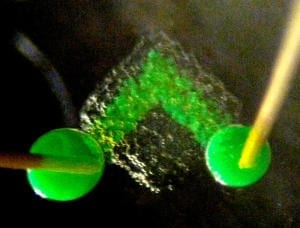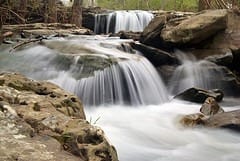
Applications include imaging man-made targets such as moving vehicles
A standard camera takes flat, 2-D pictures. To get 3-D information, such as the distance to a far-away object, scientists can bounce a laser beam off the object and measure how long it takes the light to travel back to a detector. The technique, called time-of-flight (ToF), is already used in machine vision, navigation systems for autonomous vehicles, and other applications, but many current ToF systems have a relatively short range and struggle to image objects that do not reflect laser light well.
A standard camera takes flat, 2-D pictures. To get 3-D information, such as the distance to a far-away object, scientists can bounce a laser beam off the object and measure how long it takes the light to travel back to a detector. The technique, called time-of-flight (ToF), is already used in machine vision, navigation systems for autonomous vehicles, and other applications, but many current ToF systems have a relatively short range and struggle to image objects that do not reflect laser light well. A team of Scotland-based physicists has recently tackled these limitations and reported their findings today in the Optical Society‘s (OSA) open-access journal Optics Express.
The research team, led by Gerald Buller, a professor at Heriot-Watt University in Edinburgh, Scotland, describes a ToF imaging system that can gather high-resolution, 3-D information about objects that are typically very difficult to image, from up to a kilometer away.
The new system works by sweeping a low-power infrared laser beam rapidly over an object. It then records, pixel-by-pixel, the round-trip flight time of the photons in the beam as they bounce off the object and arrive back at the source. The system can resolve depth on the millimeter scale over long distances using a detector that can “count” individual photons.
Although other approaches can have exceptional depth resolution, the ability of the new system to image objects like items of clothing that do not easily reflect laser pulses makes it useful in a wider variety of field situations, says Heriot-Watt University Research Fellow Aongus McCarthy, the first author of theOptics Express paper.
“Our approach gives a low-power route to the depth imaging of ordinary, small targets at very long range,” McCarthy says. “Whilst it is possible that other depth-ranging techniques will match or out-perform some characteristics of these measurements, this single-photon counting approach gives a unique trade-off between depth resolution, range, data-acquisition time, and laser-power levels.”
The primary use of the system is likely to be scanning static, man-made targets, such as vehicles. With some modifications to the image-processing software, it could also determine their speed and direction.
One of the key characteristics of the system is the long wavelength of laser light the researchers chose. The light has a wavelength of 1,560 nanometers, meaning it is longer, or “redder,” than visible light, which is only about 380-750 nanometers in wavelength. This long-wavelength light travels more easily through the atmosphere, is not drowned out by sunlight, and is safe for eyes at low power. Many previous ToF systems could not detect the extra-long wavelengths that the Scottish team’s device is specially designed to sense.
The scanner is particularly good at identifying objects hidden behind clutter, such as foliage. However, it cannot render human faces, instead drawing them as dark, featureless areas. This is because at the long wavelength used by the system, human skin does not reflect back a large enough number of photons to obtain a depth measurement. However, the reflectivity of skin can change under different circumstances. “Some reports indicate that humans under duress—for example, with perspiring skin—will have significantly greater return signals,” and thus should produce better images, McCarthy says.
Outside of target identification, photon-counting depth imaging could be used for a number of scientific purposes, including the remote examination of the health and volume of vegetation and the movement of rock faces, to assess potential hazards. Ultimately, McCarthy says, it could scan and image objects located as far as 10 kilometers away. “It is clear that the system would have to be miniaturized and ruggedized, but we believe that a lightweight, fully portable scanning depth imager is possible and could be a product in less than five years.”
The Latest Bing News on:
ToF systems
- Discover the next generation of mass spectrometry for high-throughput screeningon May 3, 2024 at 12:55 am
1 A fully automated dispensing and analysis system for MALDI-TOF analysis has been created by integrating a high-speed liquid handling workstation with ultrafast mass spectrometric detection. This ...
- Liquid Handling Systems Market Size Worth $8.07 billion by 2031 at a CAGR of 7.8%: Straits Researchon April 29, 2024 at 7:20 am
The key players in the global liquid handling systems market are Danaher Corporation, Agilent Technologies, Inc., Analytik Jena AG, Beckman Coulter, Inc., Bio-Rad Laboratories, Inc., Eppendorf AG, ...
- Enhance ToF Mass Spectrometry with Low-Noise, High-Speed ADCson April 9, 2024 at 12:25 pm
A low-noise, high-speed ADC is critical to the system performance of ToF MS. As previously discussed, the accuracy of time measurement and the system noise level are two important specifications ...
- Agilent Certified Pre-Owned 6545XT AdvanceBio LC/Q-TOFon March 2, 2024 at 7:28 am
The Agilent 6545XT AdvanceBio LC/Q-TOF system is designed to handle multiple workflows in biopharmaceutical characterization. When you need to access the most information at the intact protein level, ...
- DJI Inspire 3 review – great heightson December 20, 2023 at 6:36 pm
Obstacle sensing is provided by six fisheye sensors, two wide-angle sensors and one omnidirectional ToF sensing system. These are highly effective, and provide confidence when flying manually and ...
- Protein quantification by the SELDI-TOF-MS–based ProteinChip® Systemon October 11, 2023 at 6:09 pm
the SELDI-TOF-MS–based ProteinChip Reader will always produce data with better reproducibility for hundreds of samples per day. To demonstrate the practical value of the ProteinChip System ...
- GC-MS – Productson August 16, 2023 at 3:11 am
The Agilent 7250 GC/Q-TOF system delivers full-spectrum, high-resolution, accurate mass data with a wide dynamic range for identifying and quantifying GC-amenable compounds The Agilent 7010B triple ...
- rapifleX - An Adapatable MALDI System from Bruker Life Sciences Mass Spectrometryon February 25, 2023 at 3:19 pm
Brukers market-leading MALDI system - the first MALDI-TOF/TOF that adapts to your needs The rapifleX is the most advanced MALDI TOF/TOF system on the market today and it is also the most adaptable.
- Keep It Real - with Native Protein MSon June 17, 2020 at 7:00 am
We have also utilized the Ion Mobility Q-TOF system to determine the Collision Cross Section (CCS) values of the native protein molecules and the result for different mAb classes and biosimiliars will ...
- MALDI PharmaPulse mass spectrometery System for Biochemical Screeningon December 4, 2018 at 11:38 am
The system offers the advantage of true label-free detection of native substrates and products in functional biochemical assays. An ultrafast MALDI-TOF system delivers analytical results in less than ...
The Latest Google Headlines on:
ToF systems
[google_news title=”” keyword=”ToF systems” num_posts=”10″ blurb_length=”0″ show_thumb=”left”] [/vc_column_text]The Latest Bing News on:
ToF imaging system
- Researchers unveil single-shot and complete polarization imaging system using metasurfaceson May 2, 2024 at 8:03 am
Think of all the information we get based on how an object interacts with wavelengths of light—aka color. Color can tell us if food is safe to eat or if a piece of metal is hot. Color is an important ...
- Airborne single-photon lidar system achieves high-resolution 3D imagingon April 25, 2024 at 7:00 am
Researchers have developed a compact and lightweight single-photon airborne lidar system that can acquire high-resolution 3D images with a low-power laser. This advance could make single-photon lidar ...
- Imaging Science Bachelor of Science Degreeon April 9, 2024 at 5:00 pm
RIT’s imaging science bs combines physics, math, computer science, and engineering to develop cutting-edge imaging systems for satellites, drones, AR/VR, and more. Imaging science is the study of the ...
- 6 Dynamic Imaging Science Jobson January 14, 2024 at 2:44 pm
Imaging science is a unique major that combines math, physics, computer science, and engineering to develop imaging systems used in a wide array of industries. When you hear the term imaging system ...
- Protein quantification by the SELDI-TOF-MS–based ProteinChip® Systemon October 11, 2023 at 6:09 pm
the SELDI-TOF-MS–based ProteinChip Reader will always produce data with better reproducibility for hundreds of samples per day. To demonstrate the practical value of the ProteinChip System ...
- Multispectral Imaging System Built With Raspberry Pion August 24, 2022 at 5:00 pm
Multispectral imaging can be a useful tool, revealing all manner of secrets hidden to the human eye. [elad orbach] built a rig to perform such imaging using the humble Raspberry Pi. The project is ...
- CELENA® X High Content Imaging Systemon April 4, 2020 at 5:31 am
Automated high content image acquisition and analysis for drug discovery and cell biology The CELENA ® X High Content Imaging System is an integrated imaging system designed for rapid ...
- Gas Chromatography TOF/TOF System - rapifleX MALDIon September 27, 2018 at 2:17 am
Let us help you with your inquiries, brochures and pricing requirements Request A Quote Download PDF Copy Download Brochure The rapifleX is the most advanced MALDI ...
- Autofocus Systems Informationon February 11, 2018 at 6:17 am
The signal can be a laser, light, or sound. Some autofocus systems use techniques such as optical triangulation sensing and time-of-flight (TOF) sensing. Optical triangulation position sensors use ...
- CELENA® S Digital Imaging Systemon November 1, 2017 at 9:23 am
The CELENA ® S Digital Imaging System is a comprehensive solution for capturing publication-quality fluorescence, brightfield and Phase contrast images. Sophisticated software accommodates a wide ...
The Latest Google Headlines on:
ToF imaging system
[google_news title=”” keyword=”ToF imaging system” num_posts=”10″ blurb_length=”0″ show_thumb=”left”]










